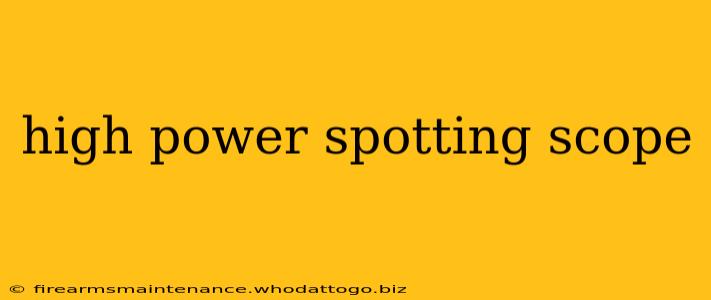Choosing a high-power spotting scope is a significant investment, demanding careful consideration of various factors. This comprehensive guide delves into the key features, benefits, and considerations to help you select the perfect scope for your needs, whether you're a seasoned birdwatcher, a dedicated hunter, or a passionate long-range observer.
Understanding High-Power Magnification
"High-power" in the context of spotting scopes generally refers to magnification levels exceeding 60x. These scopes excel at bringing distant subjects into incredibly sharp detail. However, higher magnification isn't always better. Increased magnification often comes with a trade-off: reduced field of view and increased susceptibility to vibrations and atmospheric conditions. Finding the optimal balance between magnification and image stability is crucial.
Key Factors Influencing High-Power Performance:
-
Objective Lens Diameter: A larger objective lens (e.g., 80mm, 100mm) gathers more light, resulting in brighter and clearer images, especially in low-light conditions. This is particularly important at high magnifications where light gathering is critical.
-
Image Stabilization: Image stabilization technology significantly reduces the effects of hand tremors and vibrations, making high-power observation more stable and comfortable. This is invaluable at high magnifications where even slight movements can blur the image.
-
Optical Quality: High-quality lenses and prisms (typically Bak-4 prisms) are essential for sharp, clear images with minimal distortion, chromatic aberration (color fringing), and other optical flaws. Look for scopes with fully multi-coated lenses for optimal light transmission.
-
Durability and Build Quality: A high-power scope will likely be exposed to harsh environments. Choose a scope with a robust build, waterproof and fogproof construction, and durable materials to withstand the rigors of outdoor use.
-
Tripod Compatibility: A sturdy tripod is absolutely essential for high-power spotting scopes. The heavier the scope and higher the magnification, the more stable the tripod needs to be to prevent image shake.
Types of High-Power Spotting Scopes
High-power spotting scopes typically fall into two categories:
1. Straight-Through Spotting Scopes:
These scopes offer a traditional viewing experience with a straight-through optical path. They are generally more compact and lightweight than angled scopes, making them a good choice for portability.
2. Angled Spotting Scopes:
Angled scopes provide a more comfortable viewing position, especially when observing subjects at high elevations or for extended periods. The angled design reduces neck strain and makes observation more ergonomic.
Choosing the Right High-Power Spotting Scope:
Consider these questions when making your decision:
-
What will you primarily use the scope for? Birdwatching, hunting, astronomy, or other applications will influence your magnification and feature needs.
-
What's your budget? High-power spotting scopes range significantly in price.
-
How important is portability? If you need a scope you can easily carry, prioritize a lightweight and compact model.
-
What are the typical viewing conditions? Low-light situations necessitate a larger objective lens.
-
What level of image stabilization do you require? If you anticipate hand-shaking issues, image stabilization is crucial.
Conclusion:
Selecting a high-power spotting scope involves careful consideration of your specific needs and preferences. By understanding the key features and factors discussed above, you can make an informed decision and enjoy years of crisp, clear, and detailed observation of the world around you. Remember to always prioritize quality optics, sturdy construction, and appropriate accessories like a high-quality tripod for optimal performance.

